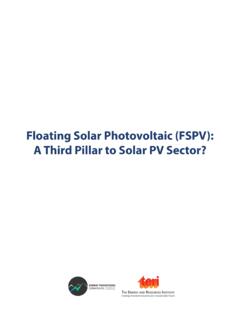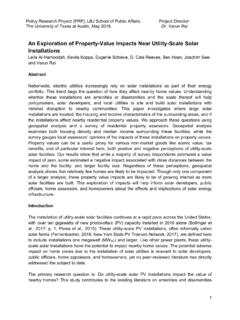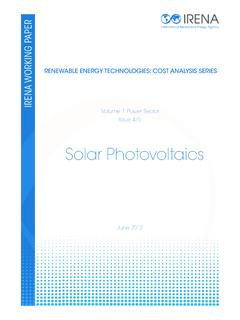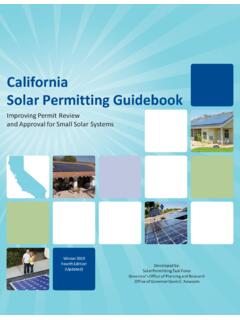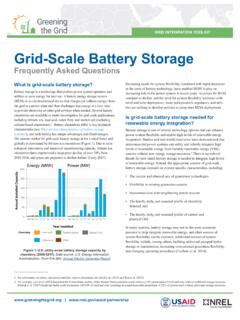Transcription of Health and Safety Impacts of Solar Photovoltaics
1 WHITE PAPER. Health and Safety Impacts of Solar Photovoltaics By Tommy Cleveland May 2017. Contents Project Installation / System Components | Solar Panels: Construction and Photovoltaic (PV) Panel End-of-Life Non-Panel System Components (racking, wiring, inverter, transformer)..12. Operations and Maintenance Panel Washing and Vegetation 2 Electromagnetic Fields (EMF)..14. 3 Electric Shock and Arc Flash Hazards ..16. 4 Fire Health and Safety Impacts of Solar Photovoltaics The increasing presence of utility - scale Solar pho- This is in addition to the value of the electricity and tovoltaic (PV) systems (sometimes referred to as suggests that the air quality benefits of Solar are Solar farms) is a rather new development in North worth more than the electricity itself. Carolina's landscape. Due to the new and un- known nature of this technology, it is natural for Even though we have only recently seen large- communities near such developments to be con- scale installation of PV technologies, the technol- cerned about Health and Safety Impacts .
2 Unfortu- ogy and its potential Impacts have been studied nately, the quick emergence of utility - scale Solar since the 1950s. A combination of this Solar -spe- has cultivated fertile grounds for myths and half- cific research and general scientific research has truths about the Health Impacts of this technology, led to the scientific community having a good un- which can lead to unnecessary fear and conflict. derstanding of the science behind potential Health and Safety Impacts of Solar energy. This paper uti- Photovoltaic (PV) technologies and Solar inverters lizes the latest scientific literature and knowledge are not known to pose any significant Health dan- of Solar practices in to address the Health gers to their neighbors. The most important dan- and Safety risks associated with Solar PV technol- gers posed are increased highway traffic during ogy.
3 These risks are extremely small, far less than the relative short construction period and dangers those associated with common activities such as posed to trespassers of contact with high voltage driving a car, and vastly outweighed by Health ben- equipment. This latter risk is mitigated by signage efits of the generation of clean electricity. and the security measures that industry uses to deter trespassing. As will be discussed in more This paper addresses the potential Health and detail below, risks of site contamination are much Safety Impacts of Solar PV development in North less than for most other industrial uses because Carolina, organized into the following four catego- PV technologies employ few toxic chemicals and ries: those used are used in very small quantities. Due (1) Hazardous Materials to the reduction in the pollution from fossil-fu- (2) Electromagnetic Fields (EMF).
4 El-fired electric generators, the overall impact of (3) Electric Shock and Arc Flash Solar development on human Health is overwhelm- (4) Fire Safety ingly positive. This pollution reduction results from a partial replacement of fossil-fuel fired generation by emission-free PV-generated electricity, which 1 Hazardous Materials reduces harmful sulfur dioxide (SO2), nitrogen ox- ides (NOx), and fine particulate matter ( ). One of the more common concerns towards Solar Analysis from the National Renewable Energy is that the panels (referred to as modules in the Laboratory and the Lawrence Berkeley National Solar industry) consist of toxic materials that en- Laboratory, both affiliates of the Department danger public Health . However, as shown in this of Energy, estimates the Health -related air quali- section, Solar energy systems may contain small ty benefits to the southeast region from Solar PV amounts of toxic materials, but these materials do generators to be worth per kilowatt-hour of not endanger public Health .
5 To understand poten- Solar tial toxic hazards coming from a Solar project, one May 2017 | Version 1 3. must understand system installation, materials used, the panel end-of-life protocols, and system Project Installation/. operation. This section will examine these aspects of a Solar farm and the potential for toxicity im- Construction pacts in the following subsections: The system installation, or construction, process ( ) Project Installation/Construction does not require toxic chemicals or processes. The ( ) System Components site is mechanically cleared of large vegetation, Solar Panels: Construction and Durability fences are constructed, and the land is surveyed Photovoltaic technologies to layout exact installation locations. Trenches for (a) Crystalline Silicon underground wiring are dug and support posts are (b) Cadmium Telluride (CdTe) driven into the ground.
6 The Solar panels are bolt- (c) CIS/CIGS ed to steel and aluminum support structures and Panel End of Life Management wired together. Inverter pads are installed, and Non-panel System Components an inverter and transformer are installed on each ( ) Operations and Maintenance pad. Once everything is connected, the system is tested, and only then turned on. Figure 1: utility - scale Solar facility (5 MWAC) located in Catawba County. Source: Strata Solar May 2017 | Version 1 4. System Components Solar Panels: Construction and Durability Solar PV panels typically consist of glass, polymer, and assembled into panels, thin film technologies aluminum, copper, and semiconductor materials consist of thin layers of semiconductor material that can be recovered and recycled at the end of deposited onto glass, polymer or metal substrates.
7 Their useful Today there are two PV technol- While there are differences in the components and ogies used in PV panels at utility - scale Solar facil- manufacturing processes of these two types of so- ities, silicon, and thin film. As of 2016, all thin film lar technologies, many aspects of their PV panel used in North Carolina Solar facilities are cadmium construction are very similar. Specifics about each telluride (CdTe) panels from the US manufacturer type of PV chemistry as it relates to toxicity are First Solar , but there are other thin film PV panels covered in subsections a, b, and c in section ;. available on the market, such as Solar Frontier's on crystalline silicon, cadmium telluride, and CIS/. CIGS panels. Crystalline silicon technology con- CIGS respectively. The rest of this section applies sists of silicon wafers which are made into cells equally to both silicon and thin film panels.
8 To provide decades of corrosion-free operation, cell encapsulation. For decades, this same mate- PV cells in PV panels are encapsulated from air rial has been used between layers of tempered and moisture between two layers of plastic. The glass to give car windshields and hurricane win- encapsulation layers are protected on the top with dows their great strength. In the same way that a layer of tempered glass and on the backside a car windshield cracks but stays intact, the EVA. with a polymer sheet. Frameless modules include layers in PV panels keep broken panels intact a protective layer of glass on the rear of the pan- (see Figure 4). Thus, a damaged module does not el, which may also be tempered. The plastic eth- generally create small pieces of debris; instead, it ylene-vinyl acetate (EVA) commonly provides the largely remains together as one piece.
9 May 2017 | Version 1 5. Figure 4: The mangled PV panels in this picture illustrate the nature of broken Solar panels;. the glass cracks but the panel is still in one piece. Image Source: to/115259576 PV panels constructed with the same basic com- ing products are available in versions engineered ponents as modern panels have been installed for wind speeds of up to 150 miles per hour, which across the globe for well over thirty The is significantly higher than the wind speed require- long-term durability and performance demonstrat- ment anywhere in North Carolina. The strength of ed over these decades, as well as the results of PV mounting structures were demonstrated during accelerated lifetime testing, helped lead to an in- Hurricane Sandy in 2012 and again during Hurri- dustrystandard 25-year power production warran- cane Matthew in 2016.
10 During Hurricane Sandy, ty for PV panels. These power warranties warrant the many large- scale Solar facilities in New Jer- a PV panel to produce at least 80% of their origi- sey and New York at that time suffered only minor nal nameplate production after 25 years of use. A In the fall of 2016, the US and Carib- recent SolarCity and DNV GL study reported that bean experienced destructive winds and torrential today's quality PV panels should be expected to rains from Hurricane Matthew, yet one leading so- reliably and efficiently produce power for thirty-five lar tracker manufacturer reported that their numer- ous systems in the impacted area received zero damage from wind or Local building codes require all structures, includ- ing ground mounted Solar arrays, to be engineered In the event of a catastrophic event capable of dam- to withstand anticipated wind speeds, as defined aging Solar equipment, such as a tornado, the sys- by the local wind speed requirements.
